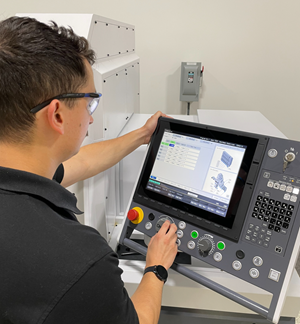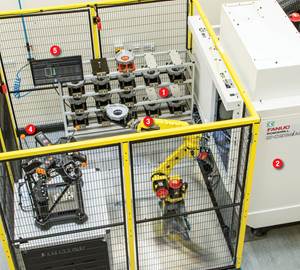Italian IIOT: Cautious but Confident
Although The Industrial Internet of Things (IIOT) was a popular topic at Bi-Mu, the biennial machining and manufacturing exhibition in Milan, Italy, technology suppliers seem to have adopted a cautious outlook.
Share





Amid all the hype about what is being called the next phase of the industrial revolution, it’s natural for machine tool builders to seek to contribute in any way possible to the Industrial Internet of Things (IIOT). Yet, doing so just for the sake of being in that space can risk moving too fast at the expense of system reliability and performance.
So said Massimo Carboniero, freshly appointed president of Italian machine tool association UCIMU and vice president of metal-forming machine manufacturer Omera, during a press conference at the 30th edition of the Bi-Mu/SFORTEC trade show in Milan. These comments weren’t meant to suggest that technology facilitating the “smart factories” of the future shouldn’t be (or isn’t already) of utmost importance to Italian machine tool builders, which displayed their wares at the Fieramilano exhibition center October 4-8 along with more than 1,000 other technology suppliers from all over the world. Far from it, in fact. Reflecting Mr. Carboniero’s sentiments, most of these manufacturers of mostly large, made-to-order machine tools are, indeed, claiming a place at the proverbial table. At the same time, however, the mood from booth to booth seemed markedly reserved—not negative or unenthusiastic, just cautious, realistic about hurdles and wary of overhype.
For instance, many builders made the point that much of the capability that people tend to group under the IIOT umbrella isn’t truly new. Customers such as large aerospace OEMs have long demanded spindle uptime percentages in the upper ‘90s, they say. Gathering data through machine-mounted sensors has long been a way to provide the deep operational intelligence needed to achieve that goal. Consider that Mandelli, a specialist in horizontal machining centers, has offered SCADA supervisory and control capabilities for decades. Representatives there and at other booths were happy to tout what they see as already-extensive real-world experience right along with their new, perhaps more exciting capabilities in this area.
Other builders offered similar software, each version with its own twists. For instance, Breton’s Naviman system enables using eyeglasses with embedded cameras to record procedures in first-person perspective for training, evaluating and comparing strategies, or any other purpose.
On the show floor, all of this seemed exciting indeed, but in the real world, technology like this is still in its infancy. That was one takeaway from a visit to MCM, a manufacturer of machine tools as well as pallet changers and flexible manufacturing systems. Guiseppe Fogliazza is director of MCE, the 30-year-old, dedicated software division of MCM. He says one persistent challenge is that, despite significant advances in providing a common “language” for networking disparate types of equipment, communications standards such as OPC Unified Architecture or MTConnect can limit the ability to provide what he calls “multi-level, hierarchical models.” As an example of this, he cites two functions that any plant interested in IIOT would monitor closely on every machine: operating status (i.e., running, down for maintenance, down for unexplained reasons, etc.), and machining parameters like feeds and speeds. The former might change by the minute, and the latter changes by the second. Nonetheless, a common standard might put both on the same level. This is inherently wasteful, he says. As Mr. Fogliazza puts it, the system must “read the whole book every second,” as opposed to just a chapter.
Based on their booth demonstrations and touted capabilities, Italian machine tool builders that exhibited at Bi-Mu have plenty to offer when it comes to IIOT. However, they’re also thoughtful and realistic in their assessments of what exactly is possible at this very early stage of what’s being called the next industrial revolution.
For more on Bi-Mu and the technology on display, view this slideshow.
Related Content
Swiss-Type Control Uses CNC Data to Improve Efficiency
Advanced controls for Swiss-type CNC lathes uses machine data to prevent tool collisions, saving setup time and scrap costs.
Read More5 Stages of a Closed-Loop CNC Machining Cell
Controlling variability in a closed-loop manufacturing process requires inspection data collected before, during and immediately after machining — and a means to act on that data in real time. Here’s one system that accomplishes this.
Read MoreProcess Control — Leveraging Machine Shop Connectivity in Real Time
Renishaw Central, the company’s new end-to-end process control software, offers a new methodology for producing families of parts through actionable data.
Read MoreBlueprints to Chips: CAD/CAM Tips and Tricks
This collection of articles delves into the latest CAD/CAM innovations, from AI-driven automation and optimized tool paths to the impact of digital twins and system requirements.
Read MoreRead Next
How I Made It: Dennis Rymanowski
Dennis Rymanowski has worked at NSH USA for 60 years, with his passion for manufacturing living alongside his passion for his family’s polka band.
Read MoreA New Frontier in Surface Finish Control
What if your machine tool could measure surface roughness as it cuts? This article explores how in-process metrology is advancing from concept to reality, enabling real-time feedback, immediate detection of anomalies and new levels of control over surface quality. Discover the technologies making this possible.
Read More






















